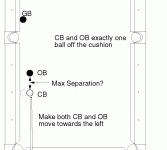Good video. I'd like for you to have not said "quite a bit to the right" since in reality, it wasn't. It was just a bit to the right. Certainly not to the extent that others like to draw (here and in books)dr_dave said:Fred,
I'm sorry I misinterpreted your earlier message about whether the shot could be made.
FYI, my July '07 article touches on this topic. Also, see NV B.21.
Regards,
Dave
But, in the end, this shot with dirty balls on Shot #2 is only a little bit of spin induced throw. It's not the tremendous amount, nor is it a trivial thing to try to hit the object ball fairly full and throw it over. Shot number #2 is really what the OP was trying to do. I think this is a significant amount of throw to miss a shot, but it's not 1" per 12" either. It looks like 2" over 8 feet.
So, I think the answer still is: in the shot that the OP set up, you can't significantly throw that ball over to the left of the diamond like they're trying. And if they're using clean balls, they've got no shot whatsoever.
Fair or not fair?
Fred
